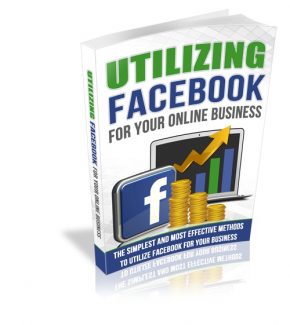 License Type: Resell Rights
License Type: Resell Rights  File Type: ZIP
File Type: ZIP
 SKU: 61010
SKU: 61010  Shipping: Online Download
Shipping: Online Download
Sample Content Preview
Introduction
Maximizing Your Business with Facebook
The term “Social Media Marketing” is becoming common. While a year ago it used to be SEO or Search Engine Optimized content, which is basically content with a few specific keywords, put in here and there, the trend nowadays is with various social networking sites like Facebook and Twitter to increase the profile of a website. The Internet is evolving quickly and something new concerning how you can improve your site's profile is coming up almost on a monthly basis.
Specifically, with Facebook there is a lot of information floating around the net about how essential it is for businesses to be on their website. Yet, many businesses have an innate fear of social networking as such because of their concerns with data security. This is the dilemma that most SMB or Small to Medium Businesses face, whether to be on Facebook or not.
This guide's purpose is to discuss in detail what exactly Facebook is and how using it can help any small business become bigger than imagined through social networking.
What is Facebook?
Facebook is a social networking site that was launched in February 2004, by January 2011, it had garnered over 600 million users. It is now considered the third largest web based company in the US after Google and Amazon and usually has more visitors every day than Google.
Even though Facebook my not be considered large when compared to the behemoths that are Google or Amazon, its growth rate has been so fast that people now feel that ignoring Facebook is at their own peril. Even a year ago, Facebook was considered as something for the younger generation – in fact when it was launched first by founder Mark Zuckerberg; it was a place where his classmates and then his college mates at Harvard could share information about themselves.
However, this has seen a radical change. While last year the under 25 age group made up 58% of the population in Facebook right now it is has come down to 40%. This is not so much because younger population is not using Facebook anymore; they still are at the same pace they used to, but because of the increase of other age groups in new registrations. A look at the registration statistics will show this. The those between the ages 35 to 55 has grown at an astounding 277% while the 55+ age group has shown a remarkable 195% increase in new registrations. This is definite proof that the “young” sheen has worn out of Facebook.
There are also other reasons for this, like Facebook's new initiatives to include businesses, with their social plug-ins and authenticating user logins. Although their analytics tool is not as sophisticated as Google's it offers much more in details including demographic information that is invaluable for most businesses.
It is not that everything is to the positive, there are negatives to using Facebook, and primary among this is the fear of data leakage in organizations. Yet, everything has its negatives, and it only remains to be seen if the positives are compelling enough to justify having a Facebook account.
This guide will be divided into three broad sections, the first would deal with why Facebook is important for most SMB's, the second will deal with how exactly they can use Facebook to their advantage, and the last will be the negatives to using Facebook.
Why Facebook is Important for Small Businesses
Increase Web Presence
This is the most basic reason for you to do anything online, because it increases your web presence. Any business has only one objective, and that is sales, be it a product or a service. The only way to do this is to make people aware that you are providing a particular product or service. Companies spend between 3% and 10% of their total sales just to do this. In corporate parlance, this is called marketing, when you advertise in different venues so that you let people know exactly what it is that you provide.
With so much of money at stake companies are always looking for ways in which they can get the same kind of exposure without spending as much money and the web is giving them that opportunity. More than 75% of the population in Western countries has broadband connections at home; more and more people are going online for their needs. Sales are slowly but surely moving towards online, and many manufacturers are already taking advantage of this.
Amazon is posting a 15% growth each year, and their profits have skyrocketed in the past couple of years. In fact, even during the downturn, they were one of the few industries that posted growth. There are a number of benefits to buying online, primary among them being lower cost and this benefit is hard to match in retail sales.
Many organizations have taken notice of this growth and even though their online marketing budget is only around 14% of their overall marketing budget, it is a large increase from last year's 8%. Everyone realizes that the future is online, but there are still a number of organizations that are still wary. It has grown so fast that it has caught many companies by surprise.
With its enormous reach, especially in certain markets and demographics where traditional marketing does not have much impact, Facebook offers an inexpensive, yet quite effective way to put your company's face on the World Wide Web. Just having a website is not enough and everyone knows this. While there are alternatives to Facebook is dominating the social network sites and their 600 million users force you to consider the amount of people that you could possibly reach. With Facebook now surpassing Google in the number of people who visit them every day, this is becoming more compelling.
Increase Brand Image
This is a carry on from the previous point. The aim behind increasing web presence is to not only increase the brand awareness, but also increase brand image. While brand awareness or brand recall is easily achieved with advertising, increasing brand image is a little more difficult. Companies spend years developing a certain image for their brand, and any decision with regards to a new product is taken considering if it will fit the brand image or not.
Online this is not as difficult. Although the basics remain the same, it is much cheaper to develop a brand online than offline. For example, customer service online is usually restricted to email and responses to blog posts and questions in the forum. This is much easier to handle, and much cheaper in fact, than real time call centers where people answer your calls.
Of course, emails may not be able to fully replace human interaction, but it can reduce it by quite a big margin. In the same way advertising as well as promotion of a product is much cheaper online than it is in the real world.
Brand building is all about creating an image of the brand in the minds of the people, and one of the easiest ways to do this is to increase the interaction between the general population and the organization. While having a website is the bare minimum that an organization should do, there is not much interaction you can have with your customers through your website. Many sites have a “contact us” link and some even have a complaints page where you can log in and put in your complaints, but doing so in Facebook just increases the personal touch.








